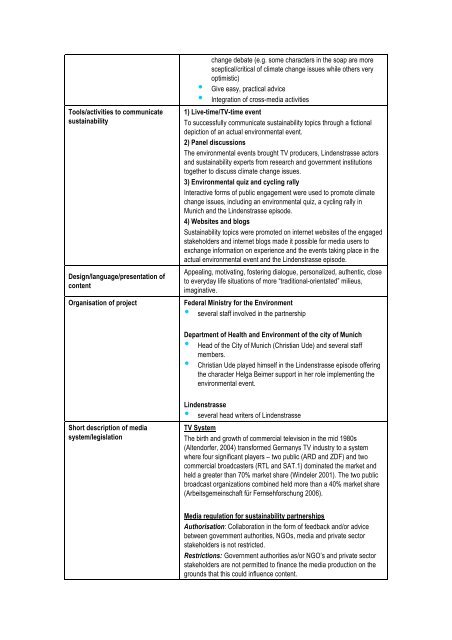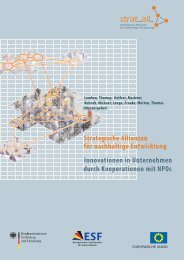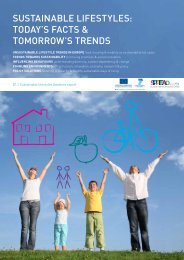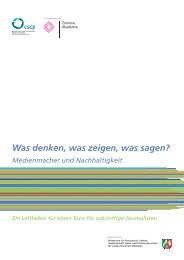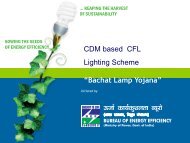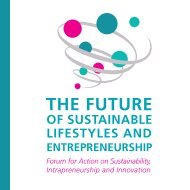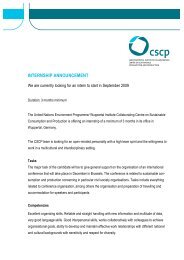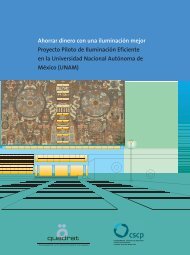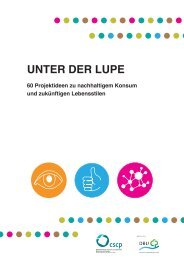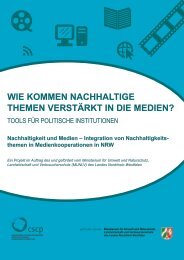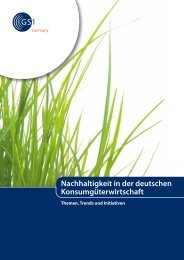integrating sustainability themes into media - Collaborating Centre ...
integrating sustainability themes into media - Collaborating Centre ...
integrating sustainability themes into media - Collaborating Centre ...
Create successful ePaper yourself
Turn your PDF publications into a flip-book with our unique Google optimized e-Paper software.
Tools/activities to communicate<br />
<strong>sustainability</strong><br />
Design/language/presentation of<br />
content<br />
change debate (e.g. some characters in the soap are more<br />
sceptical/critical of climate change issues while others very<br />
optimistic)<br />
• Give easy, practical advice<br />
• Integration of cross-<strong>media</strong> activities<br />
1) Live-time/TV-time event<br />
To successfully communicate <strong>sustainability</strong> topics through a fictional<br />
depiction of an actual environmental event.<br />
2) Panel discussions<br />
The environmental events brought TV producers, Lindenstrasse actors<br />
and <strong>sustainability</strong> experts from research and government institutions<br />
together to discuss climate change issues.<br />
3) Environmental quiz and cycling rally<br />
Interactive forms of public engagement were used to promote climate<br />
change issues, including an environmental quiz, a cycling rally in<br />
Munich and the Lindenstrasse episode.<br />
4) Websites and blogs<br />
Sustainability topics were promoted on internet websites of the engaged<br />
stakeholders and internet blogs made it possible for <strong>media</strong> users to<br />
exchange information on experience and the events taking place in the<br />
actual environmental event and the Lindenstrasse episode.<br />
Appealing, motivating, fostering dialogue, personalized, authentic, close<br />
to everyday life situations of more “traditional-orientated” milieus,<br />
imaginative.<br />
Organisation of project Federal Ministry for the Environment<br />
• several staff involved in the partnership<br />
Short description of <strong>media</strong><br />
system/legislation<br />
Department of Health and Environment of the city of Munich<br />
• Head of the City of Munich (Christian Ude) and several staff<br />
members.<br />
• Christian Ude played himself in the Lindenstrasse episode offering<br />
the character Helga Beimer support in her role implementing the<br />
environmental event.<br />
Lindenstrasse<br />
• several head writers of Lindenstrasse<br />
TV System<br />
The birth and growth of commercial television in the mid 1980s<br />
(Altendorfer, 2004) transformed Germanys TV industry to a system<br />
where four significant players – two public (ARD and ZDF) and two<br />
commercial broadcasters (RTL and SAT.1) dominated the market and<br />
held a greater than 70% market share (Windeler 2001). The two public<br />
broadcast organizations combined held more than a 40% market share<br />
(Arbeitsgemeinschaft für Fernsehforschung 2006).<br />
Media regulation for <strong>sustainability</strong> partnerships<br />
Authorisation: Collaboration in the form of feedback and/or advice<br />
between government authorities, NGOs, <strong>media</strong> and private sector<br />
stakeholders is not restricted.<br />
Restrictions: Government authorities as/or NGO’s and private sector<br />
stakeholders are not permitted to finance the <strong>media</strong> production on the<br />
grounds that this could influence content.


